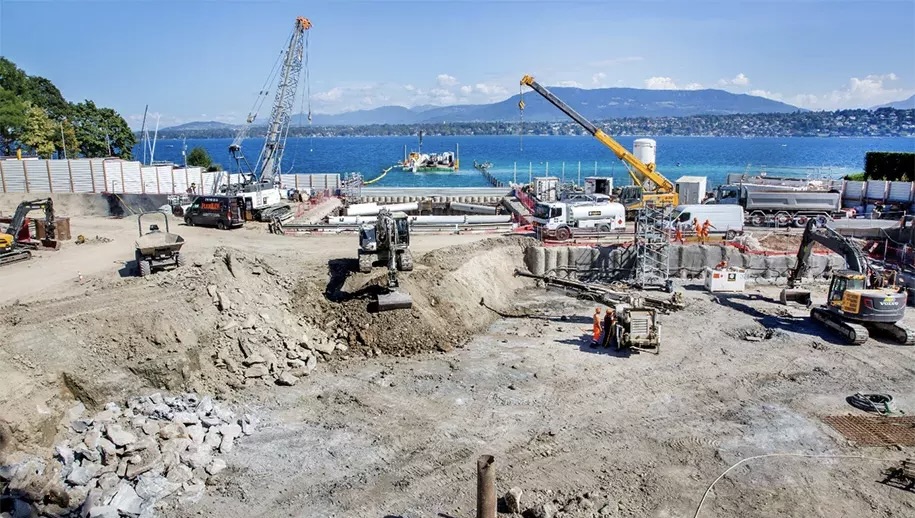By Ruben Chung, Year 12
Our beloved Lac Leman is easily the city’s most captivating feature. I’m sure we’ve all spent some unforgettable times there, whether it’s jogging, cycling, swimming, sunbathing, wakeboarding, sailing, or taking photos. Artists like Ferdinand Hodler featured our lake in some of their most well-known paintings. But did you know that under this beautiful feature of our town lies GeniLac, an innovative 100% renewable hydrothermal energy network?
GeniLac, a project started by Services Industriels de Genève (SIG) to address what SIG’s director Christian Bruiner describes as a “climate emergency”, uses cold lake water and 100% renewable energy to heat and cool buildings connected to it via a 30-kilometre-long underground network. Buildings currently generate around 40% of annual carbon emissions globally, and in Switzerland, about 70% of buildings were heated by greenhouse gas-producing sources in 2021. GeniLac will reduce the amount of energy used to cool buildings connected to it by 80%, thereby reducing carbon emissions from heating by 80%. The system will also reduce the fine particles released into the air: traditional heating systems burn mazut oil, which combusts incompletely due to its high sulphur content and long carbon chains.
Hydrothermal energy dates back to the 1930s in Switzerland, where a few small stations used it to heat certain structures. GeniLac grew out of a pioneering network called Geneva-Lac-Nations (GLN) that was established in the early 2000s to use a cooling water distribution system from the lake to climatise the UN Palais de Nations, well before the energy transition to renewables became so prevalent. After seeing the success of this installation, SIG engineers decided to expand GLN to a larger network to service more of the city. Today, GeniLac services approximately 70 buildings, including many in the United Nations district and the city centre. A few months ago, construction began to connect Geneva Airport to the network by 2026, which will save more than 2 million litres of petroleum oil annually once it is operational. SIG estimates that by 2035, GeniLac will provide heating and cooling for forty percent of the canton’s buildings, thereby reducing CO2 emissions by 70 ‘000 tons per year.

GeniLac extracts water from the lake at a depth of 47 metres and 1 km out where the water remains at 7 degrees Celsius on average all year round. The water is then piped into an underground reservoir and passed through a system of pipes connected to buildings in the network. To cool buildings, the lake water goes through a heat exchanger which transfers the lake water’s thermal energy to the water running in the buildings through pipes connected to the building’s cooling systems (lake water is always kept separate from the water running in the buildings). This cooling method replaces the need for air conditioning units that contain damaging refrigerant chemicals such as CFCs and saves energy. To heat the buildings in winter, the water would go into heat pumps, which are much more energy efficient than boilers. Once the lake water has served its purpose for heating or cooling, it is released back into the lake at a depth of 10-12 metres, where the lake temperature is closest to the water’s, to minimise changes to the lake’s average temperature.
The system is expensive, estimated to cost around 800 million francs, but it will be the largest system of its kind in Switzerland. Lake-sourced thermal energy systems are designed to last from 75 to 100 years, which is very cost-effective due to total energy savings, long life, and the necessary eventual replacement of coolers that use CFCs and usually need replacing every 30 or so years. Veronique Tanerg, media relations for SIG, explains that energy savings also come from having a collective infrastructure shared by many buildings. Each building will no longer need its own heating/cooling equipment, which saves money on energy bills, while also freeing up valuable space in the building for other uses. Most importantly, GeniLac allows the Geneva canton to take advantage of an accessible renewable energy source right in front of it, greatly reducing our reliance on fossil fuels.
There have been concerns about the impact on the Lac Leman from having warmer water released into it after each cycle of heating/cooling, but close monitoring from the State of Geneva has verified that the impact on the lake environment is minimal.
Overall, the ingenuity of GeniLac is clear. The establishment of such a large network of renewable energy will be key in creating a greener Geneva. Although there are other examples of similar systems which have been built around the world, there is still a lot of untapped potential with using waterbodies for thermal applications to accelerate the transition to renewables and reach emissions goals. In Europe alone, there are about 170 lakes that have unused thermal potential. As long as environmental impacts and biodiversity are well considered, GeniLac can serve as an excellent example for many other regions in the world where there is a lake or body of water deep enough to draw cold water from.



